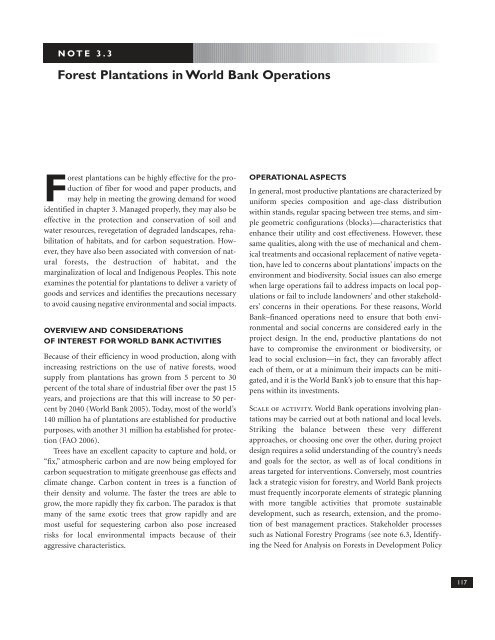Forests Sourcebook - HCV Resource Network
Forests Sourcebook - HCV Resource Network
Forests Sourcebook - HCV Resource Network
Create successful ePaper yourself
Turn your PDF publications into a flip-book with our unique Google optimized e-Paper software.
NOTE 3.3<br />
Forest Plantations in World Bank Operations<br />
Forest plantations can be highly effective for the production<br />
of fiber for wood and paper products, and<br />
may help in meeting the growing demand for wood<br />
identified in chapter 3. Managed properly, they may also be<br />
effective in the protection and conservation of soil and<br />
water resources, revegetation of degraded landscapes, rehabilitation<br />
of habitats, and for carbon sequestration. However,<br />
they have also been associated with conversion of natural<br />
forests, the destruction of habitat, and the<br />
marginalization of local and Indigenous Peoples. This note<br />
examines the potential for plantations to deliver a variety of<br />
goods and services and identifies the precautions necessary<br />
to avoid causing negative environmental and social impacts.<br />
OVERVIEW AND CONSIDERATIONS<br />
OF INTEREST FOR WORLD BANK ACTIVITIES<br />
Because of their efficiency in wood production, along with<br />
increasing restrictions on the use of native forests, wood<br />
supply from plantations has grown from 5 percent to 30<br />
percent of the total share of industrial fiber over the past 15<br />
years, and projections are that this will increase to 50 percent<br />
by 2040 (World Bank 2005). Today, most of the world’s<br />
140 million ha of plantations are established for productive<br />
purposes, with another 31 million ha established for protection<br />
(FAO 2006).<br />
Trees have an excellent capacity to capture and hold, or<br />
“fix,” atmospheric carbon and are now being employed for<br />
carbon sequestration to mitigate greenhouse gas effects and<br />
climate change. Carbon content in trees is a function of<br />
their density and volume. The faster the trees are able to<br />
grow, the more rapidly they fix carbon. The paradox is that<br />
many of the same exotic trees that grow rapidly and are<br />
most useful for sequestering carbon also pose increased<br />
risks for local environmental impacts because of their<br />
aggressive characteristics.<br />
OPERATIONAL ASPECTS<br />
In general, most productive plantations are characterized by<br />
uniform species composition and age-class distribution<br />
within stands, regular spacing between tree stems, and simple<br />
geometric configurations (blocks)—characteristics that<br />
enhance their utility and cost effectiveness. However, these<br />
same qualities, along with the use of mechanical and chemical<br />
treatments and occasional replacement of native vegetation,<br />
have led to concerns about plantations’ impacts on the<br />
environment and biodiversity. Social issues can also emerge<br />
when large operations fail to address impacts on local populations<br />
or fail to include landowners’ and other stakeholders’<br />
concerns in their operations. For these reasons, World<br />
Bank–financed operations need to ensure that both environmental<br />
and social concerns are considered early in the<br />
project design. In the end, productive plantations do not<br />
have to compromise the environment or biodiversity, or<br />
lead to social exclusion—in fact, they can favorably affect<br />
each of them, or at a minimum their impacts can be mitigated,<br />
and it is the World Bank’s job to ensure that this happens<br />
within its investments.<br />
Scale of activity. World Bank operations involving plantations<br />
may be carried out at both national and local levels.<br />
Striking the balance between these very different<br />
approaches, or choosing one over the other, during project<br />
design requires a solid understanding of the country’s needs<br />
and goals for the sector, as well as of local conditions in<br />
areas targeted for interventions. Conversely, most countries<br />
lack a strategic vision for forestry, and World Bank projects<br />
must frequently incorporate elements of strategic planning<br />
with more tangible activities that promote sustainable<br />
development, such as research, extension, and the promotion<br />
of best management practices. Stakeholder processes<br />
such as National Forestry Programs (see note 6.3, Identifying<br />
the Need for Analysis on <strong>Forests</strong> in Development Policy<br />
117

















